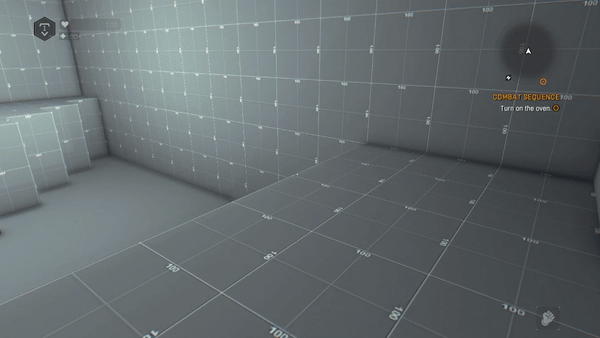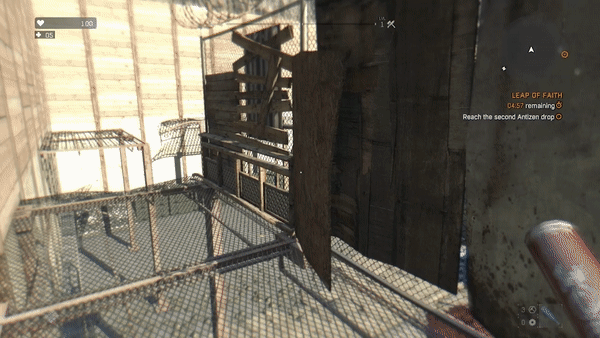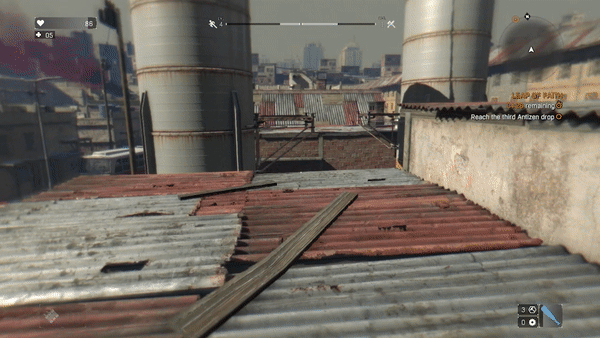top of page
Leap of Faith
Level Summary
"Leap of Faith" is a Dying Light level of my creation that takes place in an abandoned slum. The player is tasked by Jade to retrieve three Antizen drops throughout the zone.
This level was specifically constructed to serve as an artifact for my thesis titled "Best Practices in Conveying Affordances using Player-Based Metrics"

Engine:
Dying Light Developer Tools
Platform:
Development Time:
PC
20 weeks
Team Size:
Individual
Thesis Goal
Best Practices in Conveying Affordances using Player-Based Metrics
The goal of my thesis was to create a list of best practices for conveying affordances using metrics. Specifically, metrics based on the player's height. I researched pattern recognition to articulate a visual language to the player using metrics. I spent lots of time building my own metric set and choosing movement skills to test, thus, Dying Light seemed like an easy choice as a medium for this research. This list of Best Practices I created will help designers convey direction to the player in a more immersive environment without obvious design tricks such as spotlights or pain decals.
Research


Visual Language
My original thesis idea formed from reading a post from Iliu-Cosmin Oniscu, an Open World Designer who worked on Watch Dogs 2. His post talks about forming a rigid metric set that is based on the player and building your world around that metric set. This creates a visual language of what the player can do and where they can go.
(Diagrams created in sketch up by Oliu-Cosmin Oniscu)
Pattern Recognition
As my thesis developed I began researching pattern recognition theories such as the "Top-Down" approach from Nick Lund's Attention and Pattern Recognition. The theory describes our perception as requiring a hypothesis about the stimuli before fully comprehending it.
The Necker Cube on the right serves as an example to illustrate this. Some viewers see the shaded part of the square extruding out of the page, while others see the shaded part of the square indented into the square. Your perception changes based on the viewer's hypothesis of its function.


Initial Concept


Iteration
I underwent a lot of revisions during the production of this artifact. One thing I quickly realized was just how big my level would need to be to accomplish my thesis goal. I rigidly held to my design and found that the level began growing impossibly long and having lots of performance issues. To fix this I not only made the initial section wider with multiple paths for the player to take but also tripled its size. This was necessary due to the nature of my thesis focusing on free-running. The player went through too much content too quickly. Despite the visual difference I still kept a lot of the original design of my block out and I just expanded on it.

Blockout

Launch
Metrics Testing
To establish a visual language I began testing each of the Dying Light player's movement abilities. I measured out a set of minimum and maximum ranges. By sticking to these ranges I established a metrics pattern players could recognize. I decided to stick to Horizontal Jumping, Climbing, and Vaulting as the three-movement abilities I would build around.




Findings
I am currently playtesting and will post my findings here once I have them!


Postmortem
What Went Well
-
Climbing paths were very effective. Players could always climb out of dangerous situations.
-
Players' paths through the level are both always different and yet all enjoyable to run through. The level is very fast-paced and fluid.
-
Zombie crowds worked incredibly well as a deterrent to getting players off of the ground and onto my building rooftops.
-
Players missed jumps often. I believe I held to my metric sets too rigidly and should have put in some wiggle room for player error.
-
I wish I thought through the high concept more early on. My rooftop environment hurt the level's performance due to a large viewing distance. An underground aesthetic might have been better.
What Went Wrong
What I Learned
-
Having a consistent metric set sped up my development and made it easier to design the level during the iteration process. I used it to precisely craft paths for my players to take.
-
I learned a lot about what makes movement mechanics satisfying to players. It's not just about landing a jump but also having multiple ways to approach any situation.
Gallery

Rooftop Intro

Apartments

Streets

Rooftop Intro
1/6
bottom of page
